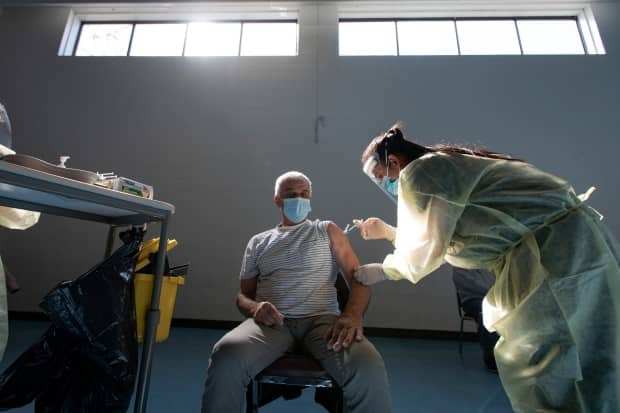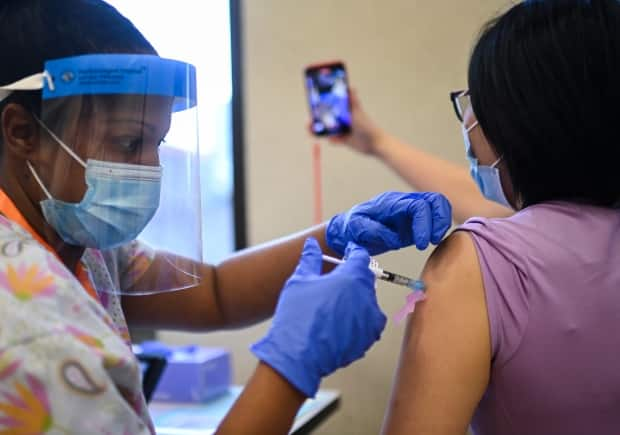What's behind Ontario's abrupt shift toward vaccinating everyone in COVID-19 hotspots

Premier Doug Ford's government has frequently altered its COVID-19 strategies, but none of those changes have seemed quite so abrupt as this week's announcement that everyone in Ontario's hardest-hit neighbourhoods aged 18 and up can get vaccinated.
The province had previously signalled there would be some extra vaccination push directed toward the places most affected by the pandemic. But all the documentation released by the Ministry of Health until this week showed that those efforts would focus on older age groups.
On Tuesday morning, senior government officials in charge of the vaccination rollout gave a detailed briefing on the timeline for April through June. It declared the start of targeted vaccinations in hotspots, but only for people aged 50 and up.
Barely 24 hours later, Ford announced that all adults in those hotspots would be eligible to get vaccinated immediately.
"As we speak, mobile vaccination teams are being organized to get vaccines to where they will have the greatest impact," Ford said Wednesday, during his news conference announcing Ontario's new stay-at-home order.
The implication in Ford's words "as we speak" was that the move had come about with lightning speed — not typical for the provincial government apparatus.
So what really happened?
The neighbourhoods in and around Toronto with the largest proportion of racialized workers have throughout the pandemic borne a disproportionate burden from COVID-19. Yet Ontario's vaccination campaign was failing to reach those very neighbourhoods. The shift in strategy notably came just days after a change of leadership in the province's vaccine task force.

Always planned
The province's own COVID-19 Science Advisory Table has for weeks called for a concerted vaccination push in the most-affected areas. Such a campaign would "directly address the inequitable impact of COVID-19 on disadvantaged populations in Ontario," said a briefing issued by the Science Table in February.
The province had always planned to pour more vaccines into high-risk areas, said Dr Isaac Bogoch, an infectious diseases specialist, member of the provincial vaccination task force and one of the co-authors of that Science Table briefing.
That still leaves open a question for the Ford government: if a full-court press in hardest-hit neighbourhoods was always the plan, why was it absent from Tuesday's detailed vaccination timeline yet suddenly present in Ford's news conference on Wednesday?
"The variants and COVID are moving at record speed and we have to be nimble in adapting to it and responding to it," said Health Minister Christine Elliott in an interview Friday.
"That's why you see sometimes these changes in plans that we just have to make because of the way COVID is moving."
WATCH | Who can get a COVID-19 vaccine in Ontario's designated high-risk zones:
Change of leadership
Ontario paid retired general Rick Hillier $20,000 a month to be head of the vaccine distribution task force. He left the post at the end of March.
One of the final efforts of Hillier's tenure was the rollout of vaccines at more than 300 pharmacies in Toronto, Kingston and Windsor. It turned out that vaccines were not allocated to pharmacies in most of the northwest and northeast portions of Toronto, the neighbourhoods worst-hit by COVID-19.

For weeks after Hillier's planned departure became public knowledge, senior government officials said that he would not be replaced. The officials said Hillier had accomplished the mission of setting up vaccine distribution channels, the system was running smoothly, and the two deputy ministers on the vaccination task force would handle things from here on in.
The government then quietly reversed course and appointed a replacement for Hillier. By contrast with the fanfare around Hillier's arrival last fall, or his departure, the government didn't even issue a news release about the new chair of the vaccine distribution task force.
He's Dr. Homer Tien, CEO of the province's air ambulance service Ornge. Tien has a lengthy background as a trauma surgeon and a three-decade career as a military physician in the Canadian Armed Forces, rising to the rank of colonel, with a role as chief of military medical and surgical specialities.

He later became medical director for the Tory Regional Trauma Centre at Toronto's Sunnybrook Health Sciences Centre, then chief medical officer for Ornge before becoming its CEO in 2019.
Dr. Peter Jüni, the head of the COVID-19 Science Advisory Table, is giving Tien significant credit for the shift to vaccinating all adults in the most-affected communities.
"The first conversation we had, the two of us, was directly related to that," said Jüni in an interview Thursday. "He [Tien] wanted to know more about our strategy that we laid out in February and whether it would indeed make sense to enhance this strategy."
The Science Table has done further data analysis showing that a concerted effort to vaccinate all adults in the high-risk neighbourhoods would result in "a dramatic increase in the control of the pandemic," said Jüni.
"Tuesday afternoon we had the science table meeting where we presented the results of our analysis. Dr. Tien was at this meeting and the results were very convincing."
CBC requested an interview with Tien, but it was declined by a spokesperson for Solicitor General Sylvia Jones, whose ministry is responsible for the vaccine task force.
Public health caught by surprise
The move to put greater emphasis on vaccinations in the places most affected by COVID-19 has widespread support from experts.
"You should really pour your water on where the fire is burning hardest to help quell the pandemic," said Bogoch in an interview this week with CBC News. He said the shift was made possible by the recent ramp up of vaccine supplies.
The move came as startling data revealed far lower vaccination rates in neighbourhoods worst-hit by COVID-19 compared with the wealthier areas where the virus has had little impact.
Sources in the provincial health ministry and local public health units tell CBC News the declaration that all adults in the hotspots would be eligible for vaccinations caught them unawares.
Plans to vaccinate younger adults in the most-affected areas were not on the table in any official health ministry documents issued before Wednesday.

For adults living in COVID-19 hot spot communities, "vaccination should begin with the oldest individuals and decreasing in age until reaching those aged 50," says the province's guidance document on priority populations for the current phase of the vaccination campaign, dated March 23.
The 22-page vaccination plan provided to journalists Tuesday does not mention vaccinating all adults regardless of age in the hard-hit neighbourhoods.
"Adults aged 50+ in 'hot spot' communities in 13 PHUs [public health units] are prioritized as part of Phase 2 of Ontario's vaccine distribution plan," the document reads.
All this could suggest the shift in emphasis and the change in leadership of the vaccine task force are not a coincidence.

113 high risk postal codes
Those aged 50 and up in all the areas designated as high-risk — 113 postal code areas stretching from Windsor to Ottawa — can now make vaccination appointments via Ontario's booking portal.
It's not yet clear how people younger than 50 will be able to sign up for vaccinations in the hardest-hit areas. A message on Ontario's COVID-19 vaccination web page says, "If you are aged 18-49 and live in a designated hot spot, find your public health unit and check their website for details about vaccination in your area."
Nor is it clear when the vaccination campaign will extend to all younger adults in all of the designated zones. For the moment, the push for vaccinating people younger than 50 starts in Toronto and Peel, due to high transmission rates.
Mobile teams and pop-up clinics will be established to administer vaccines to people aged 18 and up in high-risk areas in Toronto and Peel, as supply allows, the government said in a statement.
The government's plan allocates 920,000 additional doses of vaccine to the most-affected areas. It is far from certain that this is enough to cover the bulk of the adult population in the target areas.
CBC News asked the Ministry of Health of Friday for an estimate of the adult population in the 113 designated postal codes, but officials said they could not provide an answer until Monday.
However, using census data from 2016, CBC calculated that more than 4.2 million Ontarians live in the areas. If roughly 80 per cent are adults, vaccinating 75 per cent of the adult population with one dose would require about 2.5 million doses.
Ontario administered more than 100,000 doses of vaccine per day on three consecutive days this week. More than 2.6 million people have received at least one shot, roughly 22 per cent of the province's adult population.

